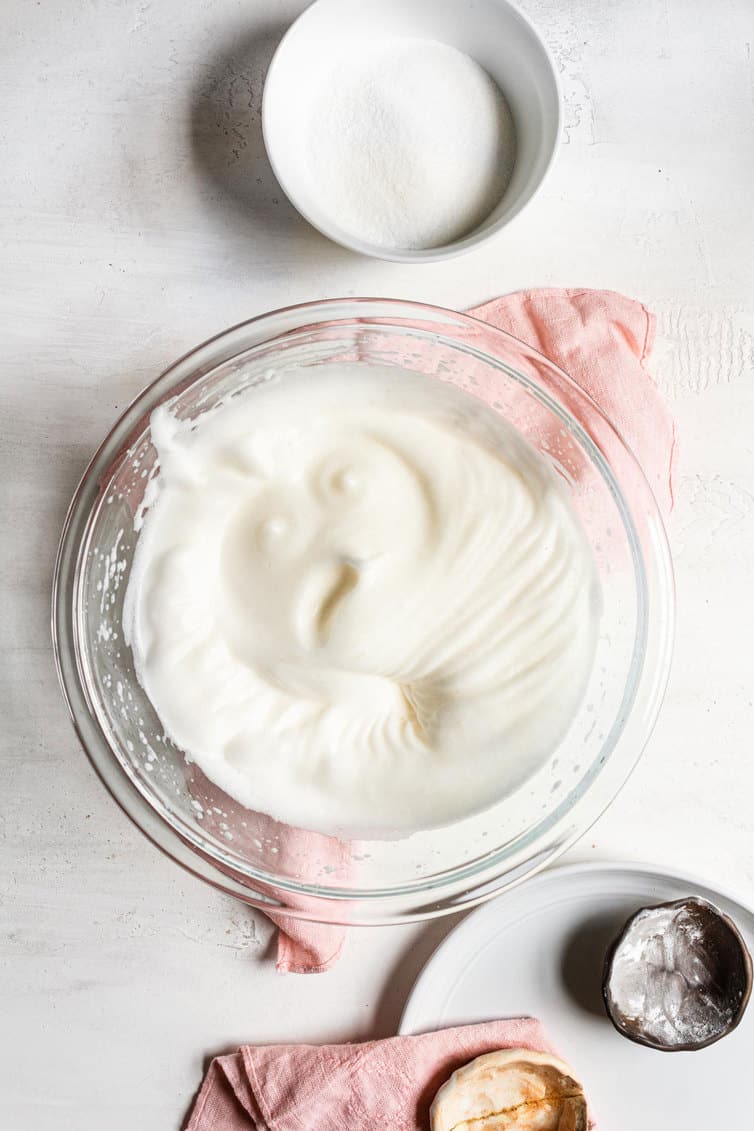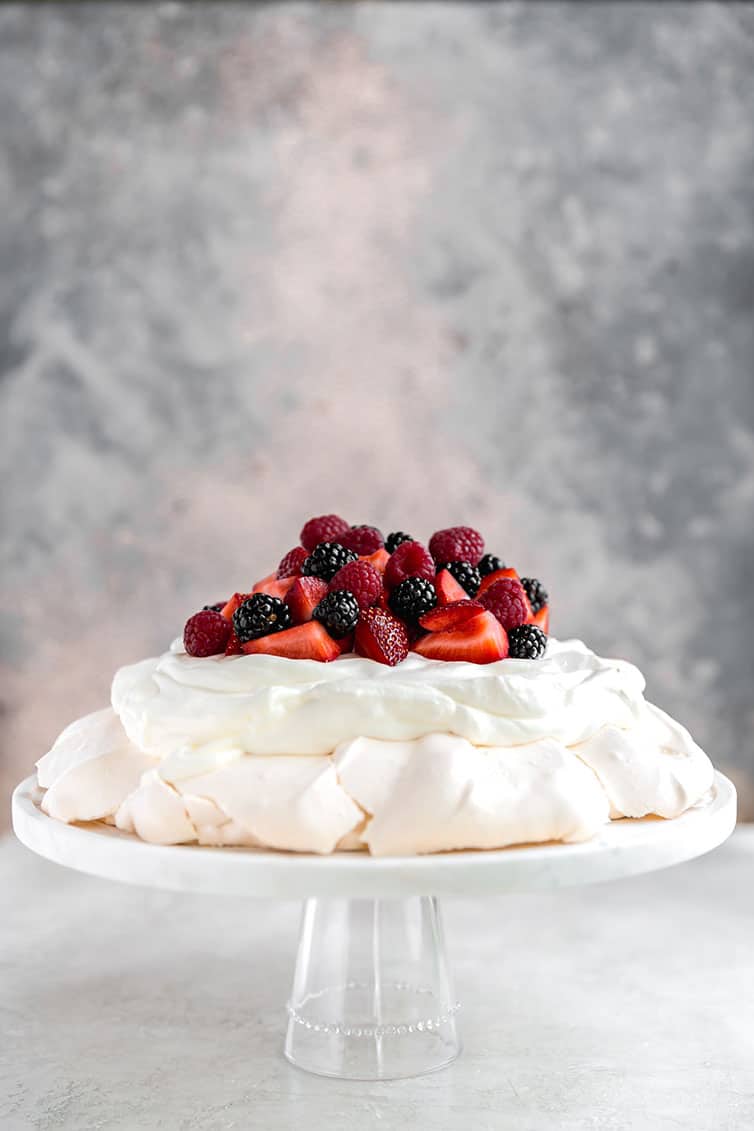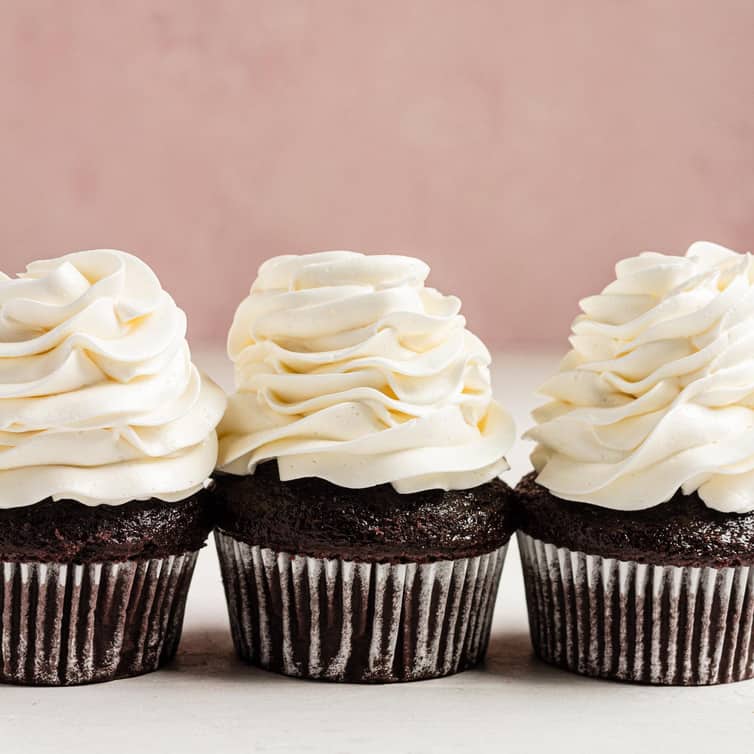How to Make Meringue: The Ultimate Guide
All of my best tips for how to make the perfect meringue, with a basic recipe, step-by-step instructions, a video, and tons of advice and troubleshooting tips to ensure your meringue whips up glossy, stiff, and beautiful each and every time!

If you’ve ever wondered, what is meringue? And how in the world can I make it?! You’ve come to the right place!
Meringue intimidates many home cooks, but I’m here to unravel the mystery and give you the confidence to grab your egg whites and start whipping the next time you see it in a recipe. You will be making it like a pro in no time!
You’ve undoubtedly heard of lemon meringue pie, but what else is meringue used for? So many things! It can top other pies and puddings, be baked to create cookies or pavlova, or mixed with butter to create some of the most luscious, silky smooth frostings you’ve ever tasted.
Meringue begins with egg whites and sugar and is transformed into billowy white clouds of pure deliciousness.
Let’s tackle it together!
Ingredients for meringue
- Eggs – Fresh eggs are best for making meringue. Using boxed or carton egg whites is not recommended, as they are usually pasteurized, and that processing can sometimes keep the meringue from getting completely glossy and stiff.
- Sugar – Can’t have a meringue without the sweetness of sugar!
- Cream of tartar – Meringue’s secret ingredient! It creates a strong, stable meringue.
- Salt + Vanilla – Flavor, flavor, flavor!
The importance of cream of tartar
This little ingredient is so important, it deserves its own section here.
Cream of tartar is an acid that stabilizes the egg whites and is what gives you those big, beautiful, billowy pillows of fluffy white meringue. To get science-y on you, it keeps the proteins from the egg whites from sticking together, which ensures a super-smooth meringue that will not wilt or deflate on itself.
How much? The general rule of thumb is to use ⅛ teaspoon for every egg white in the recipe.
Substitute: If you are out of cream of tartar and don’t have time to get to the store, you can substitute ½ teaspoon lemon juice (another acid!) for every egg white in the recipe.
Save This Recipe
Step-by-step instructions
Meringue is a fairly simple process; by following the directions and using the tips outlined below, you will be a meringue master! Here’s how we make it:
- Beat the egg whites using a mixer on medium speed (or by hand) until they are broken up and frothy.
- Add the cream of tartar, salt, and vanilla extract.
- Beat to soft peaks on medium-high speed.
- Gradually add the sugar, a couple of tablespoons at a time, until it has all been incorporated.
- Continue beating until glossy, stiff peaks form. At this point, you can’t overbeat the meringue, so keep beating until you’ve got those glossy, firm peaks!
Different types of meringue
There are three main types of meringue; while they all combine egg whites and sugar in some way, the techniques used are different, as are the applications. Let’s discuss:
French Meringue – This is the type we’re talking about today! Also known as “uncooked” meringue, it’s simply the whipping together of egg whites and sugar until peaks form; it is typically used to top pies and make meringue cookies and pavlovas and is always baked in some way after preparing.
Swiss Meringue – To make this meringue, the egg whites and sugar are heated together to a specific temperature (I always heat to 160 degrees F so it is safe to eat), ensuring the sugar has dissolved, and then mixed until room temperature, and whipped until stiff peaks form. To turn this into Swiss meringue buttercream frosting, once you have stiff peaks and the mixture is no longer warm, add butter a piece at a time, and whip until it is light, fluffy, and silky smooth. A perfect topping for cakes and cupcakes!
Italian Meringue – Italian meringue is made with hot sugar syrup. Egg whites are whipped to soft peaks in a mixer, then the sugar syrup that has been boiled to “soft ball” stage is gradually poured in while the mixer is running, then the mixture whipped until it has cooled to room temperature. Since the sugar is cooked and added to the egg whites, it is safe to eat without baking, so is perfect for recipes that use meringue toppings that are not baked, or merely torched. It is the most stable of all the meringues, holds its shape very well, and can also be turned into Italian meringue buttercream frosting with the addition of butter!
Recipe tips and troubleshooting
Follow these tips for amazing, picture-perfect meringue every single time:
- Use room temperature eggs – Separating eggs is easiest when they are cold, but then let the egg whites come to room temperature (about 30 minutes) before making the meringue; this ensures they whip up with maximum volume.
- Use a clean bowl and utensils – Even the slightest hint of fat (egg yolk, residual oil on a bowl or beaters, etc.) can prevent the egg whites from reaching stiff peaks. Ensure that everything is completely clean and dry before beginning.
- Gradually add the sugar – It’s important to add the sugar only a little bit at a time (a couple of tablespoons); adding it slowly ensures that the sugar gets absorbed into the egg whites and eliminates a gritty texture, and also reduces the chances of the meringue collapsing and failing to reach stiff peaks (this can happen if a lot of sugar is added all at once).
- You can’t overbeat meringue – It’s true! You can’t ruin it by mixing too much, so once all of the sugar is added, be sure that it is glossy and that you have super firm, stiff peaks when you remove the beater from the mixer. Don’t be afraid to mix a little longer if it appears too soft.
- Adding colors/flavors – If you want to add different flavors, you should do so when the vanilla extract is added. To make a colored meringue, add food coloring (I recommend gel food coloring to eliminate extra liquid being introduced into the recipe) once the meringue has reached stiff peaks, and beat until the color is completely incorporated.
- Recommended equipment: The easiest way to make meringue is with a stand mixer (hands-free!), but I routinely make it with my trusty hand mixer. You can also make it by hand, just use a large wire whisk and some elbow grease! It will take a little longer, but it can be done!
- Check the weather: Meringue is notoriously sticky and difficult to whip into stiff peaks on humid days. While central heating and cooling eliminate most problems, I do notice a difference when I work with it or bread dough (my grandma used to say the same about her pizzelles!) on a dry winter day vs a warm summer day, even with central air. To keep issues at bay, opt for a day with low humidity.
What to make with meringue:
- Pavlova: Try a classic pavlova, a pavlova layer cake, or even a chocolate pavlova!
- Cookies: Make a batch of chocolate chip meringue cookies.
- Pie: Lemon meringue pie is a classic, but you can top any citrus-y or even cream pie with meringue!
- Pudding: Classic southern-style banana pudding is topped with a gorgeous meringue.
If you make this recipe and love it, I would so appreciate it if you would take a moment to leave a rating below. Thank you so much! ❤️️

Basic Meringue Recipe
Ingredients
- 5 egg whites
- ½ teaspoon cream of tartar
- ½ teaspoon vanilla extract
- Pinch salt
- ½ cup (99 g) granulated sugar
Instructions
- Using an electric mixer with the whisk attachment (or a hand mixer), beat the egg whites on medium speed until frothy, then add the cream of tartar, salt, and vanilla extract.
- Increase the mixer speed to medium-high and beat to soft peaks. While continuing to beat the egg whites, gradually add the granulated sugar and beat until glossy and stiff peaks form.
Notes
- Eggs - Use room temperature eggs. Egg whites from a box or carton are not recommended.
- Clean bowl and utensils - Even the slightest hint of fat (egg yolk, residual oil on a bowl or beaters, etc.) can prevent the egg whites from reaching stiff peaks. Ensure that everything is completely clean and dry before beginning.
- Gradually add the sugar - It's important to add the sugar only a little bit at a time (a couple of tablespoons); adding it slowly ensures that the sugar gets absorbed into the egg whites and eliminates a gritty texture, and also reduces the chances of the meringue collapsing and failing to reach stiff peaks (this can happen if a lot of sugar is added all at once).
- You can't overbeat meringue - It's true! You can't ruin it by mixing too much, so once all of the sugar is added, be sure that your meringue is glossy and that you have super firm, stiff peaks when you remove the beater from the mixer. Don't be afraid to mix a little longer if it appears too soft.
- Adding colors/flavors - If you want to add different flavors, you should do so when the vanilla extract is added. To make a colored meringue, add food coloring (I recommend gel food coloring to eliminate extra liquid being introduced into the meringue) once the meringue has reached stiff peaks, and beat until the color is completely incorporated.
- Equipment: The easiest way to make meringue is with a stand mixer (hands-free!), but I routinely make it with my trusty hand mixer. You can also make it by hand, just use a large wire whisk and some elbow grease! It will take a little longer, but it can be done!
- Weather: Meringue is notoriously sticky and difficult to whip into stiff peaks on humid days. While central heating and cooling eliminate most problems, I do notice a difference when I work with meringue or bread dough on a dry winter day vs a warm summer day, even with central air. To keep issues at bay, opt for a day with low humidity.
- Recipes using meringue: For tons of ideas, see the links in the post above.
Did you make this recipe?
Leave a review below, then snap a picture and tag @thebrowneyedbaker on Instagram so I can see it!
[Photography by Dee of One Sarcastic Baker]















Thank you! Great info.
I just made meringue for the very first time and I used your recipe and wow! It is fantastic! Thank you so much!
You’re welcome! So glad you enjoyed!
When I make a coconut cream pie, the filling is cooked. Should I cool the filling before topping it with the meringue?
I have been told that you should NOT cool the filling. Applying the meringue to the HOT filling cooks the underside of the meringue, helps stop it from weeping, and seals it to the filling. Cover all of the filling and “seal it.”
Agree with the other comments posted, no point in providing a recipe if the time to cook and oven temperature is not printed,
I will try.
Looks marvelous.
This is stupid- after all the complex directions you forgot to
say what to bake them at and for how long!
You don’t have to bake it, it’s just a meringue recipe
Harsh Joan. With all the great information given you could
have shown some grace. (And wouldn’t your recipe have
dictated baking time?)
Joan gets a 1 star rating.
Excellent meringue…nice stiff peaks, great flavor…had never used vanilla before
I’m planning on making this meringue today unfortunately you haven’t added oven temperature
Ive never made meringue in the past i was always intimated by the thought…but this recipe turned out perfect easy instructions and tips…ty again
ho long do youcook amerangue in a chocolate pie How to keep it from shringing. What temperature?
Super simple process and it was delicious. I used lemon juice and it worked great. Thanks for such a perfect recipe.
I’m making a key lime pie with a meringue. I would like to make the pie on Thursday so that it can chill thoroughly and serve it on Friday. However, I find that the meringue can get rather sticky overnight. Do you think I can make the pie on Thursday, chill it, and then add my meringue on Friday and brown it?
Yes that would definitely work!
Thank you for your response!
Hello,
My question is about stable, strong meringues. I am curious which meringue is the strongest that can stand up to a dense bread batter without deflating.
(Also, this site/pages have WAY TOO MANY ads. It causes the site and pages to crash quite often. I understand it is a great way to keep it free and monetize, but you can’t even read more than a paragraph of your wonderful info before it crashes from the overwhelming amount of ads. It is worse than the old fabled tales of p**n ad popups.😅)
You say night about the temperature or time to bake!
It’s meringue but I appreciate the attention to detail as well as the additional info on the different types of meringue and uses. For those wondering about what temperature to bake at, I bake on the lower rack at 350°. Time is not a constant as some prefer a lighter meringue and others darker but I’d start checking on it after 8 or 9 mins and stay close by. Like roasting marshmallows, it can go pretty quick.
Mmmmm good!
Why leave out the temperature of the oven to bake, and how long. I would think this would be very important for the recipe
I agree. I made a beautiful meringue, but had no clue how long to bake it and at what temp. Had to guess. Went to google and the only advice I found was “low and slow”. Not real helpful.
I have a question regarding amounts of cream of tartar. In your article you say to use ⅛ teaspoon for every egg white. But in your recipe you gave 5 egg whites but only ½ teaspoon of cream of tartar. Shouldn’t it be 1½ teaspoons for 5 egg whites? I think my math is right, but hasn’t always been a strong point. Thanks – Robert
Hi Robert, ⅛ = 0.125… 0.125 * 5 (egg whites) = 0.625, which is a little more than ½, a little less than ⅓, so I rounded down to ½ teaspoon for ease of measurement.
No instructions on oven temp.